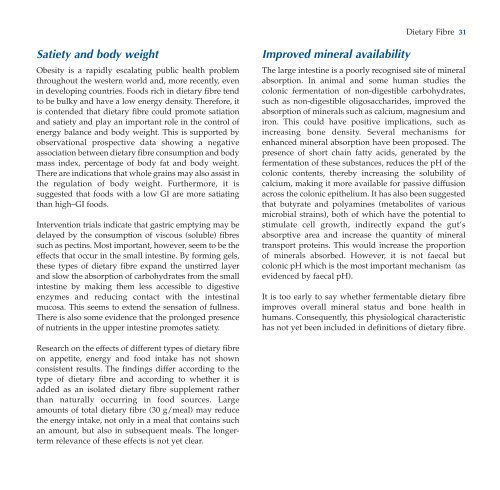Dietary Fibre - ILSI Argentina
Dietary Fibre - ILSI Argentina
Dietary Fibre - ILSI Argentina
Create successful ePaper yourself
Turn your PDF publications into a flip-book with our unique Google optimized e-Paper software.
<strong>Dietary</strong> <strong>Fibre</strong> 31<br />
Satiety and body weight<br />
Obesity is a rapidly escalating public health problem<br />
throughout the western world and, more recently, even<br />
in developing countries. Foods rich in dietary fibre tend<br />
to be bulky and have a low energy density. Therefore, it<br />
is contended that dietary fibre could promote satiation<br />
and satiety and play an important role in the control of<br />
energy balance and body weight. This is supported by<br />
observational prospective data showing a negative<br />
association between dietary fibre consumption and body<br />
mass index, percentage of body fat and body weight.<br />
There are indications that whole grains may also assist in<br />
the regulation of body weight. Furthermore, it is<br />
suggested that foods with a low GI are more satiating<br />
than high–GI foods.<br />
Intervention trials indicate that gastric emptying may be<br />
delayed by the consumption of viscous (soluble) fibres<br />
such as pectins. Most important, however, seem to be the<br />
effects that occur in the small intestine. By forming gels,<br />
these types of dietary fibre expand the unstirred layer<br />
and slow the absorption of carbohydrates from the small<br />
intestine by making them less accessible to digestive<br />
enzymes and reducing contact with the intestinal<br />
mucosa. This seems to extend the sensation of fullness.<br />
There is also some evidence that the prolonged presence<br />
of nutrients in the upper intestine promotes satiety.<br />
Improved mineral availability<br />
The large intestine is a poorly recognised site of mineral<br />
absorption. In animal and some human studies the<br />
colonic fermentation of non-digestible carbohydrates,<br />
such as non-digestible oligosaccharides, improved the<br />
absorption of minerals such as calcium, magnesium and<br />
iron. This could have positive implications, such as<br />
increasing bone density. Several mechanisms for<br />
enhanced mineral absorption have been proposed. The<br />
presence of short chain fatty acids, generated by the<br />
fermentation of these substances, reduces the pH of the<br />
colonic contents, thereby increasing the solubility of<br />
calcium, making it more available for passive diffusion<br />
across the colonic epithelium. It has also been suggested<br />
that butyrate and polyamines (metabolites of various<br />
microbial strains), both of which have the potential to<br />
stimulate cell growth, indirectly expand the gut’s<br />
absorptive area and increase the quantity of mineral<br />
transport proteins. This would increase the proportion<br />
of minerals absorbed. However, it is not faecal but<br />
colonic pH which is the most important mechanism (as<br />
evidenced by faecal pH).<br />
It is too early to say whether fermentable dietary fibre<br />
improves overall mineral status and bone health in<br />
humans. Consequently, this physiological characteristic<br />
has not yet been included in definitions of dietary fibre.<br />
Research on the effects of different types of dietary fibre<br />
on appetite, energy and food intake has not shown<br />
consistent results. The findings differ according to the<br />
type of dietary fibre and according to whether it is<br />
added as an isolated dietary fibre supplement rather<br />
than naturally occurring in food sources. Large<br />
amounts of total dietary fibre (30 g/meal) may reduce<br />
the energy intake, not only in a meal that contains such<br />
an amount, but also in subsequent meals. The longerterm<br />
relevance of these effects is not yet clear.

















